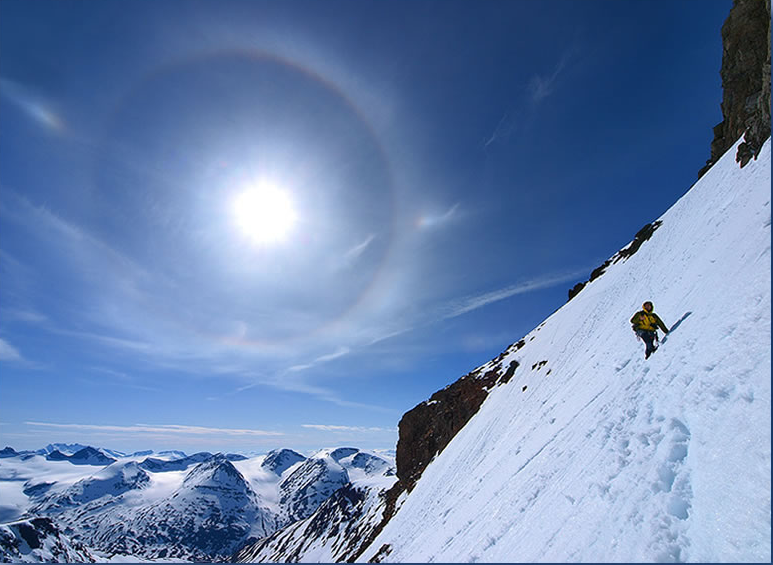Mountain Halos
Mountain Halos: A Spectacular Atmospheric Phenomenon
Mountain halos are a mesmerizing atmospheric optics phenomenon that occur in mountainous regions. These ethereal displays of light create a captivating spectacle, leaving observers in awe of the beauty and complexity of nature. While most commonly associated with the 22° halo, mountain halos can also exhibit other halo types, such as the 9° halo and the 24° halo. Additionally, they may feature parhelic circles and sundogs, further enhancing their visual appeal.
The intricate patterns of mountain halos are caused by the interaction of sunlight with ice crystals suspended in the atmosphere. These ice crystals, typically pyramidal in shape, act as tiny prisms that refract and reflect sunlight, resulting in the formation of various halos. When sunlight passes through these ice crystals, it undergoes a process called refraction, bending the light rays and creating the halo effect.
One of the most common types of mountain halos is the 22° halo. This halo appears as a circular ring around the sun, approximately 22 degrees away from its position. The 22° halo is characterized by vibrant colors, often displaying shades of red, orange, yellow, and blue. It is caused by the refraction of sunlight through hexagonal ice crystals.
In addition to the 22° halo, mountain halos can also exhibit other halo types. The 9° halo is a smaller, fainter halo that appears closer to the sun, approximately 9 degrees away. It is often seen as a pale white ring encircling the sun. The 24° halo, on the other hand, forms a larger circle around the sun, approximately 24 degrees away. It is characterized by a diffuse brightness beyond the outer ring and is suggestive of a lower 24° plate arc from partially oriented pyramidal crystals.
One of the fascinating aspects of mountain halos is their non-circular appearance when observed from certain angles. This occurs because the halos are off-center in wide-angle views, giving them an elliptical or distorted shape. This distortion adds to the visual allure of mountain halos, creating a unique and captivating experience for observers.
In some instances, mountain halos may also feature additional atmospheric phenomena. A parhelic circle, for example, can be observed crossing the sun, extending well beyond the 22° halo. This circular arc of light is caused by the reflection and refraction of sunlight through horizontally oriented ice crystals. Sundogs, also known as parhelia, are another common feature of mountain halos. These bright spots of light appear on the parhelic circle, often appearing as two glowing spots of light on either side of the sun.
Mountain halos are most commonly observed in mountainous regions due to the specific atmospheric conditions found in these areas. The presence of ice crystals at high altitudes, combined with the clear skies often found in mountainous regions, creates an ideal environment for the formation of these stunning optical displays. The elevation and temperature gradients present in mountainous terrain contribute to the unique patterns and shapes seen in mountain halos.
To capture the beauty of mountain halos, photography enthusiasts often venture to mountainous locations during optimal conditions. The interplay of light, ice crystals, and the surrounding landscape creates a visual spectacle that is truly awe-inspiring. Photographers utilize various techniques to capture the intricate details and vibrant colors of mountain halos, resulting in stunning images that showcase the wonders of nature.
In conclusion, mountain halos are a captivating atmospheric optics phenomenon that grace the skies of mountainous regions. These mesmerizing displays of light are created by the interaction of sunlight with ice crystals suspended in the atmosphere. From the vibrant colors of the 22° halo to the fainter 9° halo and the diffuse brightness of the 24° halo, mountain halos offer a visual feast for the eyes. With the addition of parhelic circles and sundogs, these displays become even more enchanting. The non-circular appearance and the unique atmospheric conditions found in mountainous regions contribute to the allure of mountain halos. Whether observed in person or through the lens of a camera, mountain halos are a true testament to the beauty and complexity of our natural world.

Halos imaged by Erik Aaseth at Skarstind, Jotunheimen National Park, Oppland County, Norway, May 28, '08.
Image ©Erik Aaseth, shown
with permission.
A colourful halo surrounds the sun, likely a 22°. However, the previous day had seen pyramidal crystal halos over Norway and they appear here too. Close to the sun there is a 9° halo and the diffuse brightness beyond the outer ring is suggestive of a 24° halo. There is possibly also a lower 24° plate arc from partially oriented pyramidal crystals.
A faint parhelic circle crosses the sun and on the circle, well beyond the 22° halo, are two sundogs.
The halos appear non circular because they are off-centre in this wide angle view.
My thanks to Marko Riikonen for the interpretation.
Note: this article has been automatically converted from the old site and may not appear as intended. You can find the original article here.
Reference Atmospheric Optics
If you use any of the definitions, information, or data presented on Atmospheric Optics, please copy the link or reference below to properly credit us as the reference source. Thank you!
-
<a href="https://atoptics.co.uk/blog/mountain-halos/">Mountain Halos</a>
-
"Mountain Halos". Atmospheric Optics. Accessed on April 23, 2024. https://atoptics.co.uk/blog/mountain-halos/.
-
"Mountain Halos". Atmospheric Optics, https://atoptics.co.uk/blog/mountain-halos/. Accessed 23 April, 2024
-
Mountain Halos. Atmospheric Optics. Retrieved from https://atoptics.co.uk/blog/mountain-halos/.